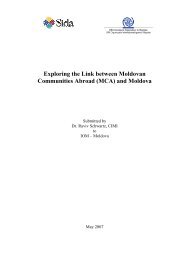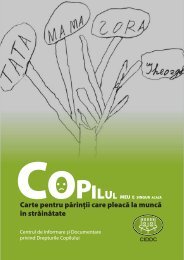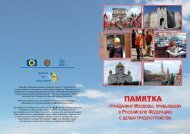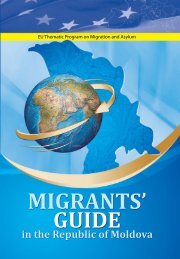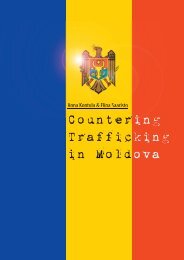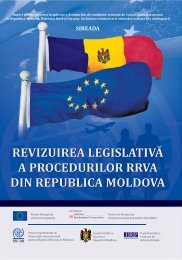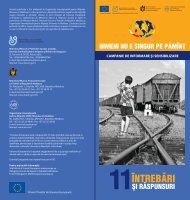Trafficking in Human Beings in Southeastern Europe - Iom
Trafficking in Human Beings in Southeastern Europe - Iom
Trafficking in Human Beings in Southeastern Europe - Iom
- No tags were found...
Create successful ePaper yourself
Turn your PDF publications into a flip-book with our unique Google optimized e-Paper software.
<strong>Traffick<strong>in</strong>g</strong> <strong>in</strong> <strong>Human</strong> Be<strong>in</strong>gs<strong>in</strong> <strong>Southeastern</strong> <strong>Europe</strong>Prostitution is a crim<strong>in</strong>al offence <strong>in</strong> Moldova, Art. 105-1 of the Crim<strong>in</strong>al Code,punished with six months to 1 year’s imprisonment. Although practiced clandest<strong>in</strong>ely,it is widespread, ma<strong>in</strong>ly <strong>in</strong> big cities. In Chis<strong>in</strong>au, there are morethan 250 brothels and sex is also sold at tra<strong>in</strong> and bus stations. The majority,70 percent, of students th<strong>in</strong>k that work <strong>in</strong> the sex <strong>in</strong>dustry abroad is a goodway to earn money. The way prostitution is viewed by the society is based ona double standard: on one hand, it is perceived as a good way to earn money;on the other, prostitutes are ostracized. For trafficked women, the fear ofrejection by their family and community is one of the factors keep<strong>in</strong>g themfrom go<strong>in</strong>g back home.Republic ofMoldova1.2. <strong>Traffick<strong>in</strong>g</strong> of childrenIn addition to traffick<strong>in</strong>g of teenage girls for prostitution, there is some anecdotal,but not confirmed, <strong>in</strong>formation about traffic <strong>in</strong> children for organs. Whilethe story is often repeated, nobody is able to present concrete facts that couldlead to the identification of the persons <strong>in</strong>volved, or at least to anyone whohas first hand <strong>in</strong>formation.<strong>Traffick<strong>in</strong>g</strong> <strong>in</strong> children for illegal adoption is reportedly widespread. There is<strong>in</strong>formation about children com<strong>in</strong>g from big families <strong>in</strong> the countryside andchildren whose parents have migrated be<strong>in</strong>g offered for adoption. 44 Thechange of the border regime between Moldova and Romania had somewhatdecreased traffick<strong>in</strong>g <strong>in</strong> children for illegal adoptions. Before June 2000, achild could be taken through the border by anyone who could present a signedagreement from the parents. Now, a child has to be registered <strong>in</strong> the accompany<strong>in</strong>gperson’s passport. Still, with widespread corruption and easy accessto new or false documents, this new requirement does not present a seriousobstacle.1.3. Victim assistance: return and re<strong>in</strong>tegrationThere were 36 persons (men and women) returned to Moldova via officialchannels <strong>in</strong> 2000. The police received them after <strong>in</strong>formation from INTERPOLabout their arrival. Moldavian police, however, have neither the capacity northe necessary skills to receive and assist trafficked persons. Return<strong>in</strong>g womenare treated like crim<strong>in</strong>als, and do not receive any proper help or support.Until recently, the only organisation that was <strong>in</strong>volved <strong>in</strong> assist<strong>in</strong>g and re<strong>in</strong>tegrat<strong>in</strong>gtrafficked persons was Save the Children Moldova. In 2000, Save theChildren assisted approximately 400 trafficked persons, and from January toJuly 2001, 217 more. These were women and girls be<strong>in</strong>g repatriated ma<strong>in</strong>ly,but not only, with the assistance of IOM. Seventeen percent of them were girlsunder 18 years old.S<strong>in</strong>ce January 2000, a larger number of trafficked persons have been returnedto Moldova with the f<strong>in</strong>ancial assistance of IOM: 308 <strong>in</strong> 2000 (assisted by Savethe Children) and 363 <strong>in</strong> 2001 (assisted by Save the Children and after September2001 by La Strada). Most of the victims were aged between 18 and24. OSCE, the International Social Service and the Catholic Church of Italyhave also assisted some of the victims. Currently, it is estimated that about20-30 women and girls return to Moldova each month. Most of them are com<strong>in</strong>gback from FYR Macedonia, Serbia, BiH, Kosovo and Albania. 45 Only 50 percentof the women want to or can go back to their families. The rest need help44.Interview with local NGO Centre of Support for Women from H<strong>in</strong>cesti Town, Ecater<strong>in</strong>aBucur, Chis<strong>in</strong>au, 26 July 2001.45.Interview with Save the Children president Mariana Petersel, Timisoara, 20 July 2001.27



